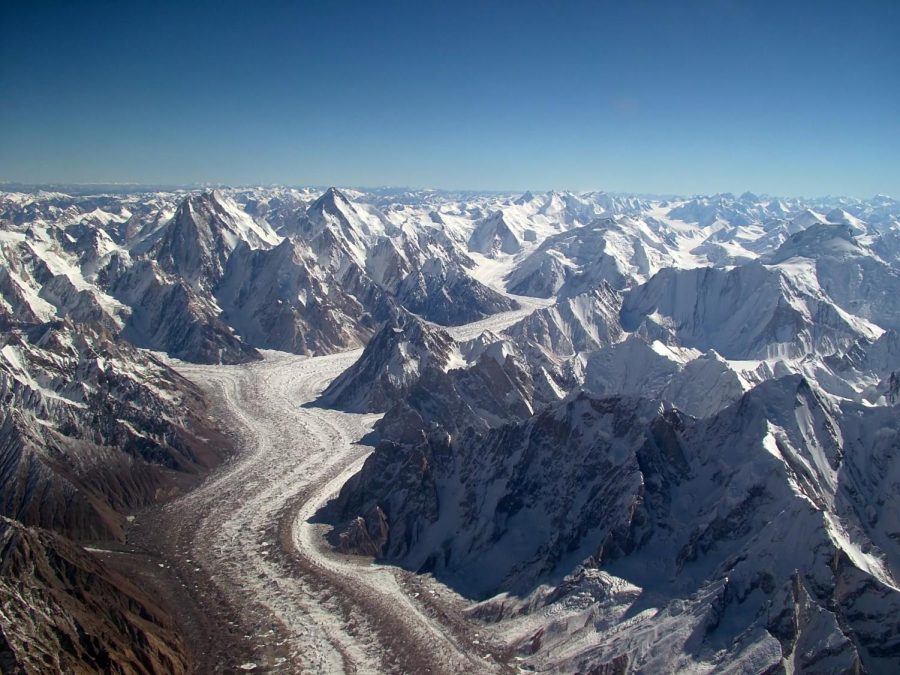Melting glaciers exacerbate Pakistan’s catastrophic floods
September 16, 2022
An onslaught of devastating flash floods has left nearly one-third of Pakistan submerged, creating inland seas where lively communities once stood.
The country suffered a death toll of at least 1,136 people, with millions displaced since the monsoon season’s start in June, according to officials.
“It’s all one big ocean, there’s no dry land to pump the water out,” Pakistan’s climate minister Sherry Rehman said, referring to the torrential floods as a “crisis of unimaginable proportions.”
This environmental disaster is only the latest in this year’s series of extreme weather events which have rocked the world’s fifth-most populous country.
In the spring, Pakistan experienced record high, drought-inducing heat. Soon after began a period of incessant rain, which has since lasted three months.
“We are using boats, camels, whatever means possible to deliver relief items to worst-hit areas,” Minister Faisal Amin Khan said. He hails from the Khyber Pakhtunkhwa Province, which has been severely affected. “We’re trying our best, but our province was hit worse now than in the 2010 floods.”
The rain, which has already washed away roads and buildings, is rendering much of Pakistan’s farmland unviable, contributing to widespread food shortages that are impacting an already vulnerable population.
“If that rainfall was distributed over the season, maybe it wouldn’t be that bad. Our systems are just not designed to manage that,” climate scientist Deepti Singh told The New York Times, referring to the powerful cloudbursts which are responsible for the destruction of infrastructure vital to Pakistanis’ livelihoods.
Pakistan’s global and physical positioning makes it unlikely for its environmental woes to lessen anytime soon.
Scientists have ranked Pakistan as one of the countries most vulnerable to climate change, despite it being responsible for only a tiny fraction of global greenhouse gas emissions.
The “recent flood in Pakistan is actually an outcome of the climate catastrophe… that was looming very large,” Anjal Prakash, a research director at India’s Bharti Institute of Public Policy, stated. “The kind of incessant rainfall that has happened… has been unprecedented,”
Pakistan houses over 7,200 glaciers, the largest amount anywhere aside from the poles.
It’s normal for glaciers, or persistent bodies of compressed ice, to shrink in the summer and grow in the winter. Lately, however, scientists have reported that the average glacier mass is shrinking as global temperatures are rising.
Thus, many of Pakistan’s nearby glaciers are melting earlier and faster, sending water to nearby streams which are already at capacity because of torrential downpours.
“We have the largest number of glaciers outside the polar region, and this affects us,” Rehman told the Associated Press. “Instead of keeping their majesty and preserving them for posterity and nature, we are seeing them melt.”
A 2021 study reported that glaciers melting in the Himalayas, one of the country’s main mountain ranges, is happening at a rate at least ten times faster than the average rate in past centuries.
Glacial runoff from the mountains can affect rivers many miles downstream by causing them to swell. It proves to be especially disastrous when this sort of occurrence coincides with monsoons, which have been occurring more irregularly due to climate change.
Additionally, water from glaciers tends to form high-elevation lakes which are occluded by glacial ice. If there’s too much runoff, which isn’t an uncommon event in the mountains of Pakistan, the ice dams can break and cause a “glacial lake outburst.”
“With this increase of glacial meltwater for the next decades — because of climate change — we will have to deal with floods,” University of Michigan Professor Ulrich Kamp said. Kamp has been researching glaciers for nearly 20 years.
Pakistan is not only grappling with the physical repercussions of the floods, but also the financial.
The country, unable to foot the $10 billion bill for damages caused by the deadly floods, is looking to the international community for help.
Some countries have already dispatched supplies and rescue teams.
The nation’s foreign minister voiced hopes that institutions such as the International Monetary Fund might provide Pakistan with financial assistance, taking into account the ongoing floods’ economic cost.
The Chinese government has announced plans to send over $300,000 and 25,000 tents in addition to the humanitarian aid it has already provided the ailing country.
Canada also intends to provide Pakistan with $5 million in funding to help deal with the flooding.
“Our carbon footprint is lowest in the world,” climate change minister Ahsan Iqbal said. “The international community has a responsibility to help us, upgrade our infrastructure, to make our infrastructure more climate resilient, so that we don’t have such losses every three, four, five years.”








